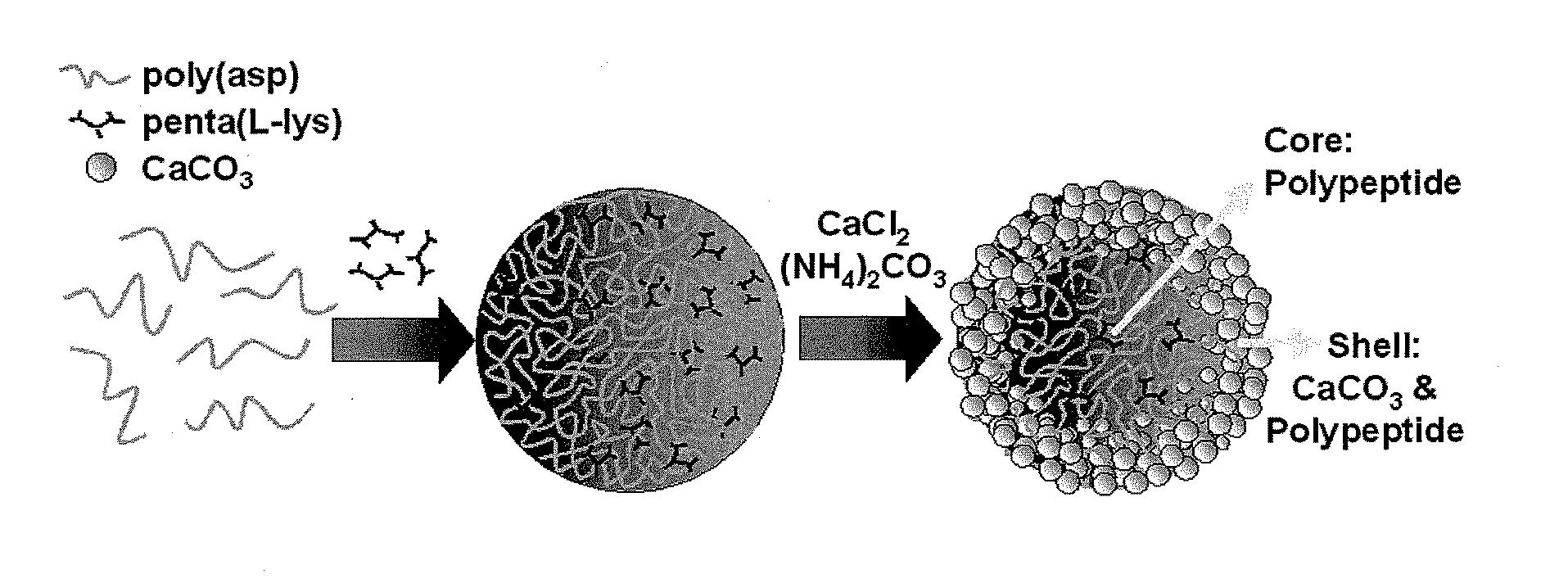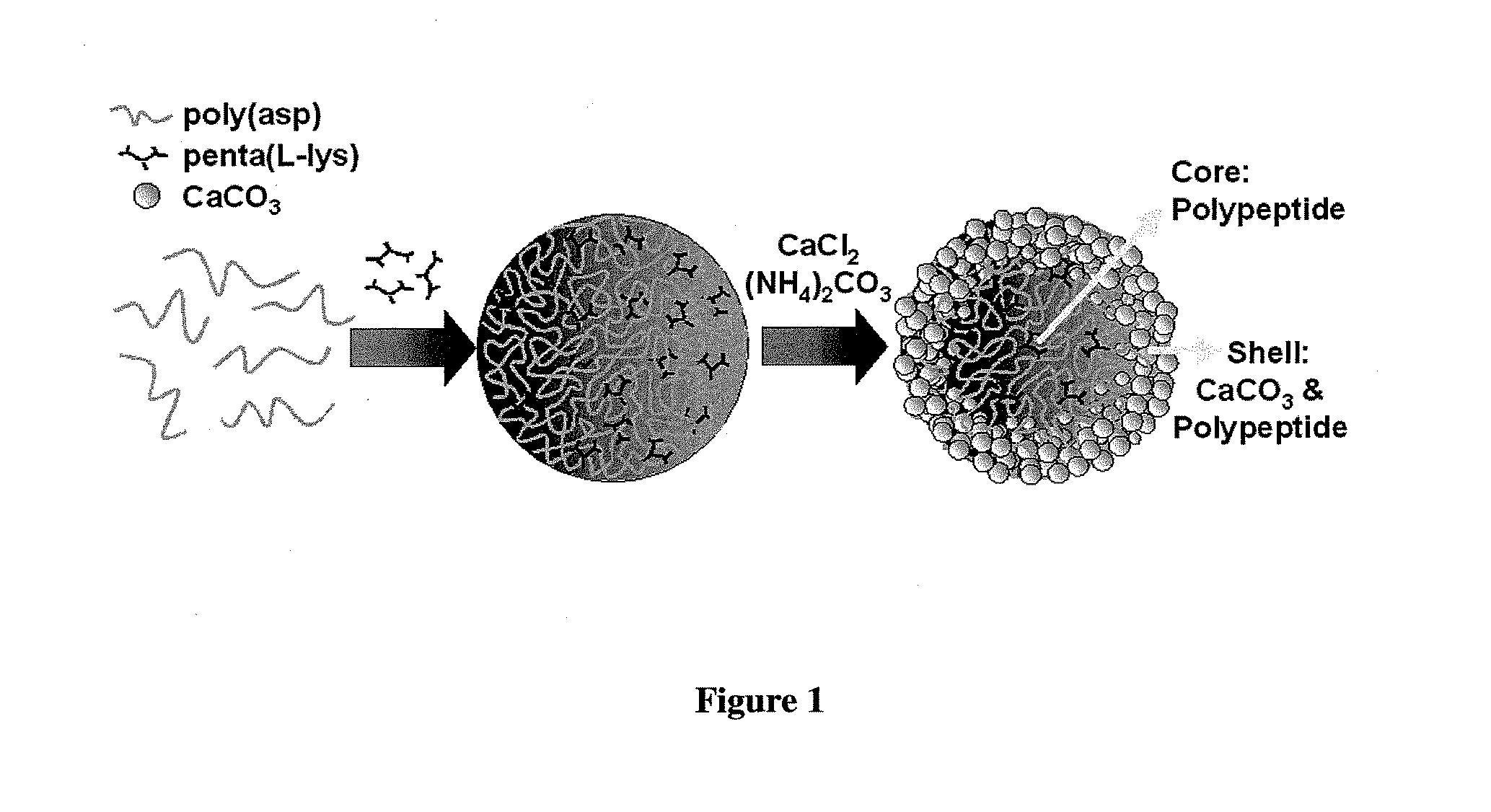Calcium carbonate microstructures useful in encapsulation applications and a process for the preparation thereof
a calcium carbonate and microstructure technology, applied in the field of calcium carbonate microstructures, can solve the problems of poor bioavailability and toxicity of many therapeutics, major drawbacks in removal after exhaustion of antibiotic activity, and severe side effects
- Summary
- Abstract
- Description
- Claims
- Application Information
AI Technical Summary
Benefits of technology
Problems solved by technology
Method used
Image
Examples
example-1
[0058]Synthesis of calcium carbonate microstructures with a spherical morphology with a core-shell structure:
[0059]In a typical synthesis to 200 μL poly(aspartate) (2 mg / mL), 200 μL, of penta(L-lysine) (2 mg / mL) was added. This mixture was then aged for 30 min at 27° C. To this mixture 200 μL of aqueous CaCl2 (0.05 M) was added followed by addition of 200 μL of (NH4)2CO3 (0.05 M). The molar ratio of the components added was 1 Ca2+:1 CO32−:0.3 poly(aspartate): 0.2 penta(L-lysine). The pH of the mixture was 8.2. This mixture was then aged for 15 hours at 27° C. The calcium carbonate precipitate then obtained was centrifuged at a speed of 9000 rpm and washed 6 times with de-ionized water and dried at 27° C. The yield of CaCO3 obtained with 30 min ageing was 30.14 wt %, which with further ageing up to 15 hours increased to 43.21 wt %. The synthesized calcium carbonate microstructures have spherical morphology with a core-shell structure where in the core is comprised of the anionic poly...
example-2
[0060]Synthesis of calcium carbonate microstructures with a spherical morphology with a core-shell structure:
[0061]In a typical synthesis to 200 μL poly(aspartate) (2 mg / mL), 200 μL of penta(L-lysine) (2 mg / mL) was added. This mixture was then aged for 0 min at 27° C. To this mixture 200 μL of aqueous CaCl2 (0.05 M) was added followed by addition of 200 μL of (NH4)2CO3 (0.05 M). The molar ratio of the components added was 1 Ca2+:1 CO32−:0.3 poly(aspartate): 0.2 penta(L-lysine). The pH of the mixture was 8.2. This mixture was then aged for 15 hours at 27° C. The calcium carbonate precipitate then obtained was centrifuged at a speed of 9000 rpm and washed 6 times with de-ionized water and dried at 27° C. The synthesized calcium carbonate microstructures have spherical morphology with a core-shell structure where in the core is comprised of the anionic polymer and multivalent cationic oligomer, and the shell is comprised of the anionic polymer, multivalent cationic oligomer and CaCO3.
example-3
[0062]Synthesis of fluorescent calcium carbonate microstructures with a spherical morphology with a core-shell structure:
[0063]In a typical synthesis to 200 μL FITC-tagged poly(aspartate) (2 mg / mL) 200 μL of penta(L-lysine) (2 mg / mL), was added. This mixture was then aged for 30 min at 27° C. To this mixture 200 μL of CaCl2 (0.05 M) was added followed by addition of 200 μL of (NH4)2CO3 (0.05 M). The molar ratio of the components added were 1 Ca2+:1 CO32−:0.3 FITC-poly(aspartate): 0.2 penta(L-lysine). This mixture was then aged for a time interval of 15 hours at room temperature. The calcium carbonate precipitate then obtained was centrifuged at a speed of 9000 rpm and washed 6 times with de-ionized water and dried at 27° C. The synthesized fluorescent calcium carbonate microstructures have spherical morphology with a core-shell structure where in the core is comprised of the anionic polymer and multivalent cationic oligomer, and the shell is comprised of the anionic polymer, multiva...
PUM
| Property | Measurement | Unit |
|---|---|---|
| Length | aaaaa | aaaaa |
| Fraction | aaaaa | aaaaa |
| Fraction | aaaaa | aaaaa |
Abstract
Description
Claims
Application Information
 Login to View More
Login to View More - R&D
- Intellectual Property
- Life Sciences
- Materials
- Tech Scout
- Unparalleled Data Quality
- Higher Quality Content
- 60% Fewer Hallucinations
Browse by: Latest US Patents, China's latest patents, Technical Efficacy Thesaurus, Application Domain, Technology Topic, Popular Technical Reports.
© 2025 PatSnap. All rights reserved.Legal|Privacy policy|Modern Slavery Act Transparency Statement|Sitemap|About US| Contact US: help@patsnap.com



